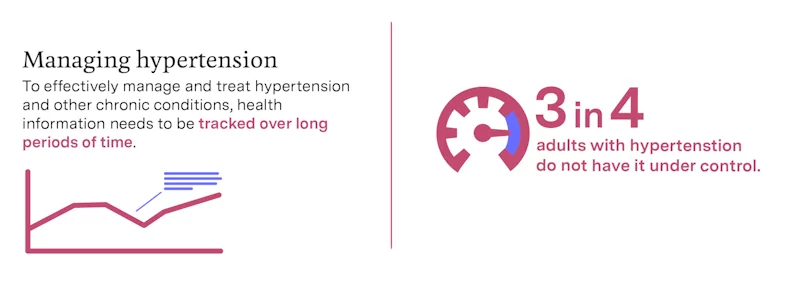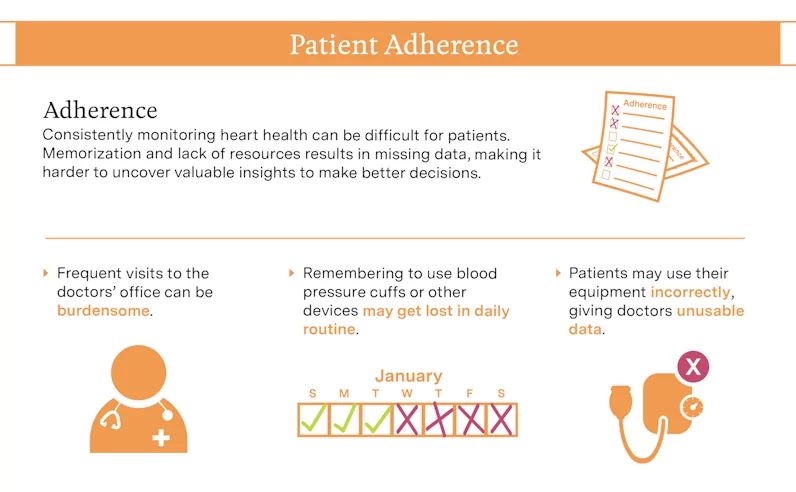This article shares findings from an interview with an individual who is currently living with hypertension. For the sake of privacy, the interviewee’s name is not shared.

Download the full infographic.
Hypertension: A Widespread Problem Demanding Solutions

According to the Centers for Disease Control (CDC), nearly half of adults (47%) in the United States have hypertension; otherwise known as high blood pressure. Despite its overwhelming prevalence, the majority of adults do not have their condition under control. For patients diagnosed with hypertension, control is the predominant goal in order to mitigate future health crises and comorbidities. Doctors will often begin treatment plans by recommending lifestyle changes, medication, or both, to ensure that their patient’s blood pressure levels are within a healthy target range. Integrating these changes into an individual’s routine is often more challenging than one might think. One patient’s experience, in particular, can attest to that:
“My doctor’s instructions sounded simple enough, but it’s a lot to remember. It all takes significant time and energy, which I don’t always have.”
– A
For many, these significant changes in lifestyle and routine can prove challenging to maintain. Keeping track of appointments, blood pressure readings, dietary restrictions, medications, and more can be a stressful process.
Managing Hypertension
Monitoring Blood Pressure
High blood pressure is a symptomless “silent killer” that quietly damages blood vessels and can lead to serious health problems. If you’re diagnosed with hypertension, it is recommended that you monitor your blood pressure regularly. Knowing what blood pressure numbers are within your normal range and maintaining an awareness of your numbers over time can enable a proactive approach to health care. Monitoring allows doctors to detect patterns and, in turn, inform a patient’s care plan. Tracking your results over time can also reveal if lifestyle or medication changes are (or are not) working. Oftentimes, consistent blood pressure monitoring is challenging for those involved:
“I try to remember to take my blood pressure daily as instructed, but all the other things get in the way, and then I’m too tired. And constantly being reminded that I’m out of my target zone when I do take my blood pressure measurement causes me more stress than good.”
– A

Lifestyle Changes
Before prescribing medication, a doctor will often recommend the following lifestyle changes first:
- Eat a well-balanced, low-sodium diet
- Limit alcohol
- Enjoy regular physical activity
- Maintain a healthy weight
- Quit smoking
The CDC has released statistics on sodium consumption in America and the numbers are staggering. On average, Americans consume more than 3,400 mg of salt per day, 1,100 mg more than the recommended daily maximum. The majority of sodium consumption (70%) comes from packaged, processed, store-bought, and restaurant foods, according to the Food and Drug Administration. This oversaturation of salt within the food market can make it especially challenging for those who need to avoid excess salt consumption for health reasons, yet sodium is only one facet of a larger problem for hypertensive patients.
“My doctor told me to eat less salt but it’s not so simple, salty meals are everywhere, and managing a specific diet is yet another thing to focus on” – A
According to the American Heart Association, these lifestyle changes are some of the most fundamental to improving blood pressure, and yet are often considered the most challenging tasks patients may face on their journey to control. Adhering to both monitoring routines and lifestyle changes are simple yet difficult practices to keep up with.

Medication
Hypertension medications, also known as an antihypertensive, are capable of lowering high blood pressure if taken properly and in conjunction with lifestyle changes. Reaching control, however, is difficult due to the various health conditions that could be the cause of hypertension. Doctors trying to prescribe medication often have to go through periods of trial-and-error with their patients, prescribing multiple types of medication (sometimes more than one at a time) to determine which works best for a particular patient.
During these trial-and-error periods, there is a delicate balance between the benefits of blood pressure control and the drawbacks of the various side effects patients must endure.
“I’ve had periods where I cannot get out of bed, the side effects are so bad. Getting on the right medications can be excruciatingly time-consuming and painful – or at least it has been for me. I’m going on over a year of trying to get on the right meds for my hypertension.”
– A
Managing Hypertension is a Lifelong Commitment
What’s important to note is that in order to manage blood pressure successfully, it requires commitment and concentrated effort from not only the patient but their entire support network. The American Family Physician Journal recommends the following:
- Establish treatment goals with your doctor
- Involve your family in your treatment program. Improving your family’s diet and exercise is helpful for everyone and may prevent other family members from developing hypertension.
- Measure your blood pressure at home and keep a daily record. This will help your doctor keep track of your progress and inform them of how effective medication and lifestyle changes are.
- Talk with your doctor if you don’t think you’re making progress in controlling your hypertension.
- See your doctor every three to six months, even if your blood pressure is under control.
Dealing with hypertension is not an easy task. Keeping track of your goals and communicating with your doctor are a few keys to success to help you manage hypertension.
Recommended insights
Casana Receives FDA Clearance for Heart Health Smart Toilet Seat
Casana announces receipt of FDA clearance for measuring Heart Rate (HR) and Oxygen Saturation (SpO2).
Casana Studies Demonstrate Shift to RPM
Download the full infographic The COVID-19 pandemic brought about a drastic cultural shift in the way people think about healthcare, with an increased demand for in-home health options. In 2020, over 29 million patients used remote...Read More
Casana Closes $30 Million Series B Funding to Accelerate Development of Novel Effortless Home Health Monitoring
Casana’s Series B led by Morningside. Matrix Partners and Series A investors General Catalyst and Outsiders Fund join the round.
